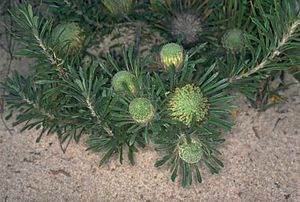Yellow honeypot facts for kids
Quick facts for kids Yellow honeypot |
|
|---|---|
 |
|
| Banksia tridentata near Cervantes | |
| Scientific classification | |
| Genus: |
Banksia
|
| Species: |
tridentata
|
| Synonyms | |
|
|
Banksia tridentata, commonly known as yellow honeypot, is a small shrub. It grows only in the southwest part of Western Australia. This plant has narrow, egg-shaped leaves with a sharp point. Its flowers are greenish-yellow and grow in groups of 85 to 125. After flowering, it produces small, egg-shaped fruits.
Contents
What Does the Yellow Honeypot Look Like?
The yellow honeypot is a shrub that usually grows to be about 15 to 50 centimeters (6 to 20 inches) tall. It has a special woody swelling underground called a lignotuber. This helps the plant survive bushfires.
Leaves and Stems
Its leaves are narrow and shaped like an egg. They are about 15 to 45 millimeters (0.6 to 1.8 inches) long. The leaves are also 2.5 to 5 millimeters (0.1 to 0.2 inches) wide. Each leaf sits on a short stem called a petiole, which is 1 to 3 millimeters long. The tip of each leaf has a small, sharp point. Sometimes, there are two or three small teeth near the leaf tip.
Flowers and Fruits
The flowers are greenish-yellow. They grow in groups, called heads, with 85 to 125 flowers in each head. At the base of these flower heads are hairy, pointed leaves called involucral bracts. These bracts can be up to 15 millimeters long.
Each flower has a part called the perianth, which is 25 to 28 millimeters long. The pistil, which is the female part of the flower, is 30 to 40 millimeters long. The yellow honeypot usually flowers from August to September.
After flowering, the plant produces fruit. These fruits are called follicles. They are slightly hairy and shaped like an ellipse or an egg. Each follicle is about 11 to 15 millimeters long.
How the Yellow Honeypot Got Its Name
This plant was first officially described in 1856. A scientist named Carl Meissner gave it the name Dryandra tridentata. He published his description in a scientific journal called Hooker's Journal of Botany and Kew Garden Miscellany.
Later, in 1893, another scientist named Benjamin Daydon Jackson made a mistake. He listed the plant under the name Banksia in a book called Index Kewensis. This accidentally created the name Banksia tridentata.
This name is now the correct one for the plant. In 2007, all species that were once called Dryandra were officially moved into the Banksia group. This change was made by scientists Austin Mast and Kevin Thiele.
Where the Yellow Honeypot Lives
The yellow honeypot grows in a special type of plant community called kwongan. This is a unique shrubland found in Western Australia. You can find Banksia tridentata growing between the Arrowsmith and Hill Rivers.
Yellow Honeypot and Its Environment
Scientists have studied how climate change might affect this plant. They found that the area where it grows might not shrink. In fact, it could even get bigger! This depends on how well the plant can move into new areas that become suitable for it to live in.
Conservation Status
The Western Australian Government's Department of Parks and Wildlife has looked at the yellow honeypot. They have classified this banksia as "not threatened." This means it is not currently in danger of disappearing.

